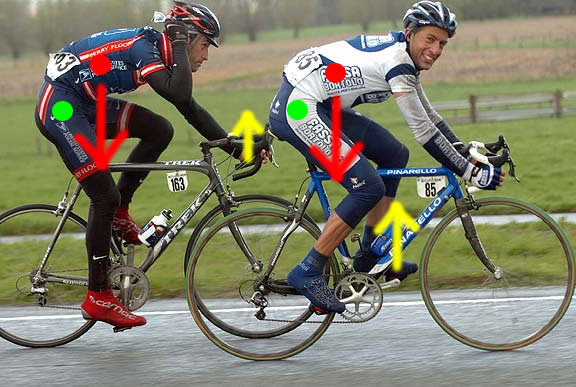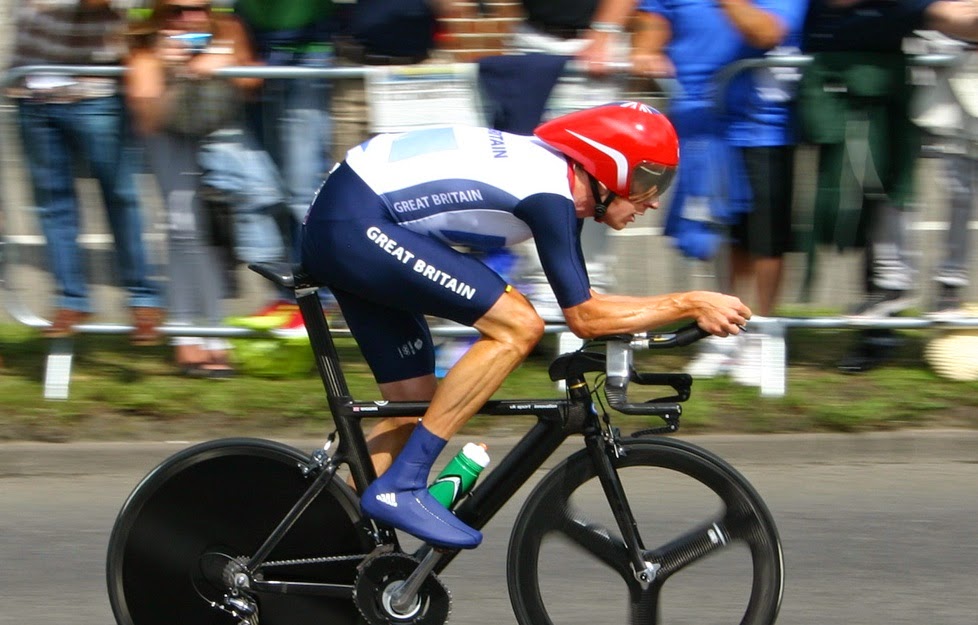Breakdown of Forces
Before looking at how to work out whether a bike will fit and how to work out what size bike would be ideal we will look at of how the bike and the body interact.
Weight distribution
For comfortable and efficient cycling you must be sitting on the saddle with your weight distributed between the saddle and the handlebars. Most of the weight must be on the saddle, and the arms must be bent and well out in front to provide shock absorption without becoming tired and stressed. The bones of the pelvis are well supported by a hard, narrow saddle and, with a little experience, quite capable of sitting on one for a long time.
Equilibrium
Linear Equilibrium
The equilibrium of the seated position must not be disturbed by the action of cycling - pedalling. Whilst it may be argued that a perfect, round pedalling action will have no resultant force in any direction, it is unlikely that any of us will ever develop the perfect action and there is, therefore, a resultant force. In order to disturb your equilibrium position as little as possible that resultant force must be countered by your body weight (gravity), and not by using your arms to stop you moving forwards or backwards. This requirement forms the basis of the Knee Over Pedal Spindle rule. More of that later...
Rotational Equilibrium
Once the tendancy to slide is removed there is still an imbalance caused by variation in pedalling force. Pedalling force in this context manifests itself as a turning moment (or torque) around the saddle. It's countered by both gravity and your arms on the handlebars. If you increase your pedalling force you must either move your centre of gravity forwards or pull on the handlebars. You move your centre of gravity by either bending forwards into a crouch or sliding forwards on the saddle. The problem with moving your centre of gravity forwards becomes evident when the pedals approach the vertical position and the pedalling force drops to almost nothing. Now your body weight is supported by your arms alone. If you moved forwards you will now want to slide back and if you crouched lower will want to crouch a little less. For all but the shortest distances, therefore, the ability to produce maximum force is be compromised by the riders ability to counteract it with strength and bodyweight.
This photo by Graham Watson (www.grahamwatson.com) illustrates what I mean.
On each of the riders I've marked a Gentre of Gravity (red dot), the point about which they rotate (green dot) and the the forces acting around that point.
The leading rider is in the middle of the power phase, the resistance of the pedal (yellow arrow) counters his bodyweight (red arrow) and there is little weight on his hands. The second rider isn't pressing down on the pedals at all so all of his body weight is supported by his hands (or hand in this case).
The riders are Juan Antonio Flecha (85) & George Hincapie (163). The race is the 2004 Gent-Wevelgem.

“Cheating”
There have been various attempts to improve on this basic, equilibrium position
and most cycle racing organisations have introduced rules to disallow them - mainly
by restricting the contact points with the bike to saddle, handlebars and
pedals.
- Backrests are disallowed - even a small lip on the back of the saddle.
- Recumbant cycles are disallowed - these provide a backrest for the rider to push against.
- Harnesses are disallowed. (A ploy by Italian team time triallists several years ago was a harness with a cord from the chest to the top tube. It was, I believe they claimed, to help them keep an aerodynamic position but I suspect it was actually an attempt to keep them on their bikes when pressing hard on the pedals.)
Tri bars
Tri-bars modify the basic equilibrium position by supporting the body using the skeleton rather than the muscles. This means that more of the body weight can be taken by the handlebars so the centre of gravity can be moved forwards without affecting equilibrium. Compare the photo below with the one above. The tri-bars support the body weight through the dead spot when the pedals don't



